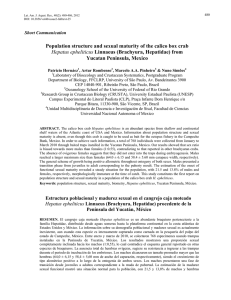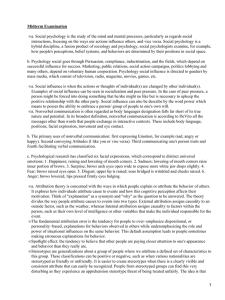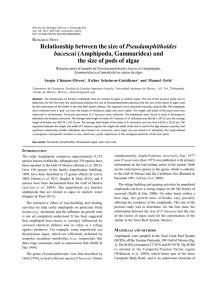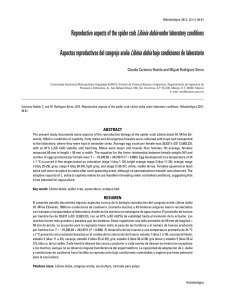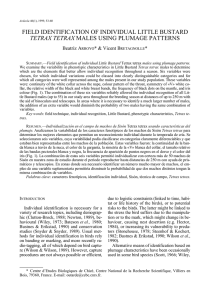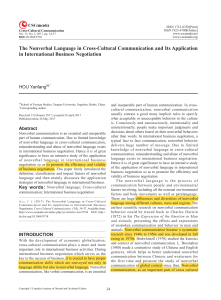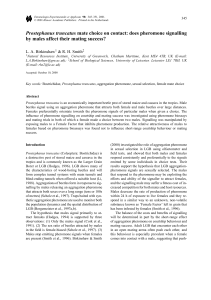Getting that female glance: Patterns and consequences of male
Anuncio
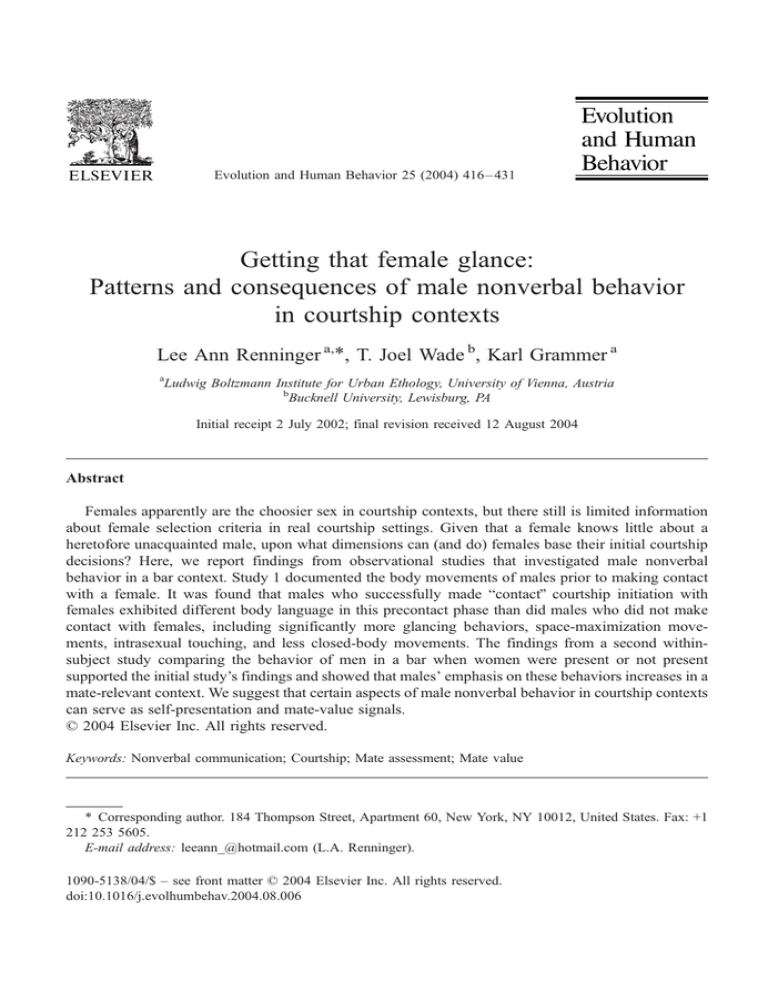
Evolution and Human Behavior 25 (2004) 416 – 431 Getting that female glance: Patterns and consequences of male nonverbal behavior in courtship contexts Lee Ann Renninger a,*, T. Joel Wade b, Karl Grammer a a Ludwig Boltzmann Institute for Urban Ethology, University of Vienna, Austria b Bucknell University, Lewisburg, PA Initial receipt 2 July 2002; final revision received 12 August 2004 Abstract Females apparently are the choosier sex in courtship contexts, but there still is limited information about female selection criteria in real courtship settings. Given that a female knows little about a heretofore unacquainted male, upon what dimensions can (and do) females base their initial courtship decisions? Here, we report findings from observational studies that investigated male nonverbal behavior in a bar context. Study 1 documented the body movements of males prior to making contact with a female. It was found that males who successfully made bcontactQ courtship initiation with females exhibited different body language in this precontact phase than did males who did not make contact with females, including significantly more glancing behaviors, space-maximization movements, intrasexual touching, and less closed-body movements. The findings from a second withinsubject study comparing the behavior of men in a bar when women were present or not present supported the initial study’s findings and showed that males’ emphasis on these behaviors increases in a mate-relevant context. We suggest that certain aspects of male nonverbal behavior in courtship contexts can serve as self-presentation and mate-value signals. D 2004 Elsevier Inc. All rights reserved. Keywords: Nonverbal communication; Courtship; Mate assessment; Mate value * Corresponding author. 184 Thompson Street, Apartment 60, New York, NY 10012, United States. Fax: +1 212 253 5605. E-mail address: [email protected] (L.A. Renninger). 1090-5138/04/$ – see front matter D 2004 Elsevier Inc. All rights reserved. doi:10.1016/j.evolhumbehav.2004.08.006 L.A. Renninger et al. / Evolution and Human Behavior 25 (2004) 416–431 417 1. Introduction 1.1. Nonverbal communication in courtship settings In courtship settings, one important source of mate-choice information is nonverbal communication, or bbody language.Q Research shows that body language plays an important role in forming first impressions, the communication of intentions (Hecht, Devito, Gueriero, & Spitbek, 1990), and a regulatory role in the progression of relationship contingencies (Givens, 1978). Nonverbal cues are given more credence than are verbal cues (Archer & Akert, 1977; Argyle, Alkema, & Gilmour, 1971), and females, in particular, are highly sensitive to nonverbal messages (Hall, 1978, 1984). Observational and interview studies indicate that solicitation in courtship interactions is mainly done (1) by the female and (2) through nonverbal messages. Kendon (1975) filmed a couple seated on a park bench to record the role of nonverbal cues in the progression of a kissing round. He found that it was the female’s behavior, particularly her facial expressions, which moderated the behavior of the male. Grammer, Kruck, Juette, and Fink (2000) also showed that females influence courtship encounters through nonverbal signaling. Analysis of courtship interactions showed that women moved toward a consistent nonverbal repertoire at the end of a courtship encounter and that the quantity of male verbal self-presentation varied according to the female’s nonverbal behavior. Moore (1985) analyzed nonverbal signaling within several settings to construct a catalog of female nonverbal solicitation signals. When a woman elicited certain nonverbal signals (e.g., eye contact followed by immediate eye aversion), it was found that those signals directly or indirectly resulted in the approach and/or maintained attention of a man. In the attention (soliciting interest) and recognition (acknowledging interest) phase of courtship (see Givens, 1978), the initial moves of making nonverbal contact are performed more frequently by females than by males. Females attract attention by displaying subtle nonverbal solicitation signals. These signals are important because, as Crook (1972) found, males are hesitant to approach a female in the absence of substantial eye contact and nonverbal indications of interest (see also Cary, 1976). Thus, it is usually the male who makes the first verbal conversation-initiation move with an unacquainted female, but only if he has received the appropriate nonverbal signals from the female. These findings make sense given that women, with their higher reproductive investment (Trivers, 1972), are likely to be the bselectorsQ and, thereby, the initiators in the courtship process. Such findings increase our understanding of female mate-selection mechanisms. However, further questions remain. Given limited information about a heretofore unacquainted male, upon what dimensions can (and do) females base their courtship decisions? Within a courtship setting, what can (and do) males do to increase their chances of being selected by a female? Despite the ongoing activity in human courtship research, a specific ethogram of male nonverbal behavior in field settings has yet to be constructed. The present research seeks to fill this void and to answer the aforementioned questions. 418 L.A. Renninger et al. / Evolution and Human Behavior 25 (2004) 416–431 1.2. Male nonverbal signals We hypothesize that many nonverbal behaviors displayed by men in courtship contexts work to facilitate their chances of receiving the necessary bits okay to approachQ signals of the female. Because females are the choosers, it makes sense that males might increase their chances of receiving appropriate courtship signals by nonverbally signaling the characteristics that females have been under evolutionary pressure to value. We predict that at least six main areas of nonverbal communication will be implicated in the male mate-value signaling process. 1.2.1. Intrasexual touch Person perception researchers have found that touching patterns offer affordances about the relative social status of members in a group. From an observer’s perspective, reciprocal touch is often perceived as solace, affection, and/or emotive empathy (Summerhayes & Sucher, 1978). Nonreciprocal touch, on the other hand, is often perceived as a dominance–submission pattern, or status differential (Burgoon, 1991; Summerhayes & Sucher, 1978). bTouchersQ are perceived as having more status and more social power than do those being touched, or those not touching at all (Burgoon, 1991). Because high social power is a trait that females have been under evolutionary pressure to value in a mate, we predict that, in a nonreciprocal male-to-male touching interaction (e.g., one male touches another male’s shoulder), the male doing the touching will be more successful with females than will the male who is being touched. In addition, males who reciprocate the touch of another male should be more successful with females than would males who only receive touch. 1.2.2. Space-maximization movements Within many social species, the most dominant member commands the largest space (Alcock, 1993). This tendency has been documented in humans, as well as other animals, including the command of personal as well as physical space (e.g., Henley, 1977). In addition, maximizing the body space through actions such as stretching or extending the arms/legs across adjacent chairs serves to make the male a larger/more conspicuous target. We predict that males who exhibit more space-maximization movements will be more successful with females than will males who exhibit less space-maximization movements. 1.2.3. Closed- versus open-body positioning Open-body positions include outward limb movements that avoid bcrossing offQ the main body torso (Mehrabian, 1972). Communicators with a closed or constricted body position (e.g., arms folded across the chest) are perceived as having less social power (Archer, 1980; Goffman, 1961; Schlenker, 1980). Communicators who display open-body positions are judged as more potent, active, and persuasive (Mehrabian, 1972) and more interpersonally oriented and attractive (McGinley, LeFevre, & McGinley, 1975). We predict that males who exhibit less closed-body behaviors will be more successful with females than will males who exhibit more closed-body behaviors. L.A. Renninger et al. / Evolution and Human Behavior 25 (2004) 416–431 419 1.2.4. Glancing behavior A female’s eye contact is an important regulator of a male’s approach in courtship situations (Cary, 1976; Crook, 1972), and both males and females report eye contact to be the most frequently used courtship-initiation tactic (Weerth & Kalma, 1995). In addition, females report discomfort in being approached by a male in a bar setting when she bhas not noticed/ has not yet made eye contactQ with that male (Renninger & Bradbury, in preparation). To achieve the necessary eye contact of surrounding females, a male needs to glance around. Consequently, we predict that males who exhibit more glancing behaviors will be more successful with females than will males who exhibit less glancing behaviors. 1.2.5. Gesticulation patterns Gesticulation refers to the movement of the hands and forearms to accompany, emphasize, or symbolically represent spoken words (Dittman, 1972). Dittman (1972) found that social power was communicated through the use of frequent and expressive hand gestures. In addition, bpalm-upQ gestures are perceived by observers as an indication of communicator’s openness and agreeableness (Eibl-Eibesfeldt, 1971). We predict that males who exhibit more gesturing and more palm-up gestures will be more successful with females than will males who exhibit less gesturing and less palm-up gestures. 1.2.6. Automanipulations The behavior of automanipulation is often called bautistic gestures,Q or bself-directed behavior,Q and includes such behaviors as rubbing the face, scratching, or playing with one’s hair. Automanipulations often occur out of context and lack true functions (e.g., picking invisible lint off of one’s pants). Automanipulatory behaviors are most often conceptualized as bdisplacement-like activitiesQ (Givens, 1978), a form of behavior in which tension from ambivalent motivations (e.g., desire to approach and fear of approach) is replaced by active or passive participation in a secondary activity (Harrison, 1965). The prevalence of displacement activities within the courtship rituals of many species has been noted (e.g., Dilger, 1962; Harrison, 1965; McKinney, 1965). In many cases, automanipulations become exaggerated and display-oriented that they may communicate information about general motivational state. In humans, displacement activities may serve as covert attention signals, interpreted by a receiver as a message that their presence affects the performer (Givens, 1978). We predict that the automanipulatory behaviors of males will increase as the mate relevance of the context increases. However, our expectations for contact outcomes are not clear. Castles, Whitens, and Aureli (1999) found that automanipulations can be used as a measure of interaction buncertaintyQ within nonhuman primates. They found that automanipulations increased by more than 40% when the individual was in close proximity to a dominant conspecific, compared with when the individual was in close proximity to a subordinate conspecific. In humans, excessive automanipulations may be interpreted as a sign of high social anxiety or low social power and, therefore, may not be conducive to a female’s evolutionary linked preferences. In the studies reported here, this measure will be exploratory. 420 L.A. Renninger et al. / Evolution and Human Behavior 25 (2004) 416–431 2. Study 1: Ethological study of contact successful and unsuccessful men Can male nonverbal behavior in courtship settings have mate-relevant meanings? In Study 1, we used naturalistic observation to document the nonverbal behavior of males in a bar, prior to them making verbal contact with unacquainted females. We were interested in the following questions: (1) Did males who made bsuccessfulQ contact-initiation with females act differently in the precontact phase, compared with males who did not make contact? (2) Are there nonverbal correlates of a male’s professed level of attraction to a female? 2.1. Method 2.1.1. Constructing a behavioral catalog Fifteen hours of preliminary observation were made of males interacting in contexts ranked through a prestudy to be high, medium, and low in flirtation. A continuous narrative account of all nonverbal behaviors exhibited by each male was documented (see procedure below). Utilizing these records, as well as the records of Givens (1978), Jesser (1978), Lockard (1980), Moore (1985), and Moore and Butler (1989), a nonverbal catalog was constructed (see Appendix). The catalog contains four main categories (Glancing Behavior, Physical Space Changes, Gesticulation, and Touching Behavior), with a total of 18 behavioral subcategories. 2.1.2. Procedure Forty males (age 21–34, mean age 24) were unobtrusively observed on 14 evenings from 9:30–11:00 p.m. on alternating Friday and Saturday nights in three bars located near college campuses in Pennsylvania, USA. These bars contained seating areas of similar sizes, a relatively constant crowd size (males, M = 23.9F2.6; females, M = 9.8F2.5), and an unobscured view of the room. At the beginning of each observation period, observers completed a bscan sampleQ of the number of men in the bar who (a) were not sitting in a booth, and (b) were surrounded by 10 or more people, and (c) were not accompanied by a female. One focal male was randomly selected for each observation session. Each focal male was observed for 30 min. To record all instances of the relevant behaviors, observers kept a continuous narrative account of all behaviors exhibited by each subject. Field notes were made using a concealed audio recorder, coded according to the behavioral catalog. Two female observers, one hypothesis blind, made the observations and transcribed the field notes. Throughout the study, the two observers were seated at separate tables, each sitting opposite to a male confederate, to make the observation and dictation of field notes less obtrusive. In two of the three locations, observations were made from a second-story loft seating area. Estimates of interobserver reliability were calculated for 12 h of observation using the following formula (McGrew, 1972): [No. of agreements (A+B)]/[No. of agreements (A+B)+No. seen by B only+No. seen by A only]. Four behaviors with an interrater reliability less than .50 were excluded from further analysis (head tilt, plus face, shoulder shrug, L.A. Renninger et al. / Evolution and Human Behavior 25 (2004) 416–431 421 and orientation change). The range of interobserver reliability scores for the remaining 14 behaviors was .71–1.00, with the average score equaling .84 (see Appendix). After the observation period ended, a male researcher administered a survey to all individuals within the vicinity of the focal male, as well as to the focal male. The experimenter asked the group if they would mind bhelping [him] out by filling out a quick survey on bar environments.Q The survey asked the participants to rate aspects of the bar experience, including an evaluation of possible future entertainment venues at the bar, the amount of alcoholic beverages they had consumed in the past 3 h, the bamount of attraction [they feel] toward one or more females present,Q on a scale of high, medium, or low. The survey administrator did not make contact with the study’s confederates at any time during the data collection sessions. For 1 h following the completion of the survey, the intersexual contact status of the focal male was noted. If the focal male achieved 1 min or more of continual conversation with a female, he was coded as having successfully initiated conversational bcontact.Q Those who did not establish 1 min or more of continual conversation with a female were coded as having a bnoncontactQ outcome. One man who reported high levels of alcohol consumption (6+ beverages consumed in the past 3 h) and one man who chose the bcan’t say/don’t knowQ option for the question of alcohol consumption were excluded from further analyses. The final sample included 38 men. All focal males were debriefed upon exiting the bar and asked to sign a consent form. All 38 men agreed to sign the consent form and none indicated suspicion that the study had taken place. The study was approved and monitored by Bucknell University’s Institutional Review Board (IRB). A series of five ANOVAs were computed to examine how the catalog behaviors related to the contact outcome and the self-reported attraction measure. To control the Type 1 error rate for the family of tests, the alpha .05 was divided by the number of statistical tests computed (see Bland & Altman, 1995). The alpha was thus reduced from .05 to .01. A chi-square analysis of the association of outcome and attraction was computed. 2.2. Results and discussion 2.2.1. Nonverbal correlates of contact outcome The first question of the study was, did bcontact-successfulQ males exhibit nonverbal patterns that were different than of those who were bcontact unsuccessful?Q We predicted that male nonverbal behavior in courtship contexts might serve as a mate-relevant signal, and that males who achieve contact with females may have more frequently signaled attributes that females have been under evolutionary pressure to value. Significant differences were found in five catalog areas. Contact-successful males exhibited a larger number of Type 2 glances [glances that are short and direct; F(1,37) = 24.22, p b .001, d = .41], more space-maximization movements [ F(1,37) = 16.59, p b .001, d = .32], more location changes [ F(1,37) = 9.70, p b .004, d = .21], more nonreciprocated touches to surrounding males [ F(1,37) = 8.62, p b .006, d = .19], and a smaller number of closedbody movements [ F(1,37) = 14.30, p b .001, d = .28], compared with the noncontact males 422 L.A. Renninger et al. / Evolution and Human Behavior 25 (2004) 416–431 (see Table 1). No significant differences were found for contact outcome in the other catalog areas. 2.2.2. Nonverbal correlates of males’ reported attraction level Does the frequency of exhibited catalog behaviors vary according to the amount of attraction that a male feels to one or more females in the bar? A male’s amount of attraction was indexed by his response to this question on the bar environment survey. Of the 38 focal males, 9 reported feeling blowQ attraction to one or more surrounding females, 16 reported feeling bmoderateQ attraction, and 13 reported feeling bhighQ attraction. Significant differences in the behavior of these groups were found in two areas: spacemaximization movements [ F(2,37) = 7.17, p b .002, d = .29] and automanipulation targeting the body area [ F(2,37) = 13.01, p b .001, d = .44]. Participants with moderate attraction levels had the most space-maximization movements, while those indicating low attraction levels had the least. Participants with high attraction levels had the most amounts of automanipulations targeting the body area (e.g., scratching the arm or shoulder), while those indicating low attraction levels had the least. Two behaviors approached significance: total glances [ F(2,37) = 3.89, p b .03, d = .18] and automanipulations targeting the beard-growth area [e.g., rubbing the chin; F(2,37) = 3.93, p b .029, d = .18]. Participants with high levels of attraction exhibited more total glancing behaviors and more automanipulations targeting the beard-growth area than did those with low levels of attraction (Table 2). 2.2.3. Cross-tabulation on outcome and professed amount of attraction A final question of Study 1 was, is there a correlation between a contact outcome and the amount of attraction that the males reported feeling? Of the 11 males in the contact outcome, 1 reported low, 7 reported medium, and 3 reported high attraction on the bar environment survey. A chi-square analysis revealed that outcome and attraction level were not significantly associated (v 2 = 4.07, df = 2, p = .13). Table 1 Study 1: Means and standard deviations of significant behaviors as a function of bcontact-initiation outcomeQ Outcome No contact (n = 27) Glancing behavior Type 2 glance Physical space changes Space maximization Closed-body movement Location change Touching behavior Nonreciprocated touch Contact (n = 11) 6.03F4.23 13.73F4.71*** 10.48F6.11 8.67F4.19 0.22F.51 19.45F6.28*** 3.73F1.49*** 0.82F.61** 0.003F19 Higher mean numbers indicate greater behavioral frequency for the 30-min observation session. ** ANOVA analysis, p b .01. *** ANOVA analysis, p b .001. 0.45F.69** L.A. Renninger et al. / Evolution and Human Behavior 25 (2004) 416–431 423 Table 2 Study 1: Means and standard deviations of significant behaviors as a function of self-reported level of attraction to women in the bar Level of attraction Glancing behavior Total glances Physical space changes Space maximization Touching behavior AM: Beard-growth area AM: Body area Low n = 9 Medium n = 16 High n = 13 10.67F4.97 17.4F6.33 16.59F6.22* 7.11F3.98 17.2F7.27 12.5F6.49** 3.56F1.74 3.78F2.05 6.74F3.19 6.4F3.6 7.78F3.54* 13.35F6.74*** Higher mean numbers indicate greater behavioral frequency for the 30-min observation session. * ANOVA analysis, p b .05. ** ANOVA analysis, p b .01. *** ANOVA analysis, p b .001. The results of Study 1 suggest that certain aspects of male nonverbal behavior in courtship contexts may be relevant to mate selection. To further examine this possibility, we conducted Study 2. 3. Study 2: Within-subject comparison of men’s behavior in a bar when women are present or not To further investigate the patterns and consequences of male nonverbal behavior in courtship-relevant contexts, a repeated-measures design was used to determine the extent to which nonverbal behaviors differ in the presence of women from the behaviors when women were absent from the same bar. If the nonverbal behavior of males in courtship settings functions as a courtship self-presentation display, systematic patterns in signaling should be limited to mate-relevant contexts. 3.1. Method 3.1.1. Behavioral catalog The behavioral catalog utilized in Study 1 was also used in Study 2. 3.1.2. Procedure Nine men (ages ranged from 25 to 50 years) were covertly observed at a bar that routinely hosted all-male meetings with subsequent informal socializing. This bar was not one of the locations in Study 1. The bfemales-absentQ condition was created through a unique situation: During the afternoon hours, monthly meetings for several large groups took place in rooms adjacent to the main area of the bar. After the meetings ended, typically 8:00–9:00 p.m., members of unaffiliated groups would often move to the bar 424 L.A. Renninger et al. / Evolution and Human Behavior 25 (2004) 416–431 location. Because the groups were composed of relatively few females, there were several occasions in which the interactions of males could be observed within a bar devoid of females. The research site was a popular bar location; not long after the meetings ended, other males and females entered the bar, typically 8:30–9:30 p.m. This created the bfemales-presentQ condition. On-site security surveillance films were analyzed. On three different occasions, 1 month of footage was scanned in a reverse direction to find time periods that fit the within-subject design criteria. Footage was selected if an individual man was present on nights containing a period of time when at least five women were present in the room and a period when all women were absent from the room. Additionally, we attempted to match the two conditions on the total number of people present. The criteria for focal male selection established in Study 1 was applied in Study 2. Following the format discussed in Study 1, the behavior of focal males was documented for a 30-min observation period in the females-present condition, as well as a 30-min observation period in the females-absent condition. A running narrative account of all observable behaviors was coded according to the behavioral catalog (see Appendix). The protocol was approved by Bucknell University’s IRB, and permission was given by the bar owner. Because the actual purpose of the footage was for security monitoring, signs indicating that security surveillance footage was being taken were posted in the bar throughout the recording period. 3.2. Results A comparison of ranges within the standard error of the mean indicated that, in the presence of females, there was an increase of movements in three catalog areas: spacemaximization movement, total amount of automanipulation, and total amount of glancing behavior (both Types 1, short glances, and 2, sweeping glances). All other behavioral categories remain unchanged across contexts. Most specifically, when in the presence of females, the nine males exhibited almost twice as many automanipulations to the jaw/beardgrowth area than they had in the female-absent condition, and almost twice as many glances (see Table 3). Table 3 Study 2: Mean and S.D. behavior frequency displayed by nine men when women were absent or present at the bar Glancing behaviors Total glancing behaviors Type 1 glances Type 2 glances Physical space changes Space-maximization movements Touching behavior Total automanipulations Automanipulations to beard-growth area Females absent Females present 7.7F2.1 2.7F1.2 5.1F1.5 13.7F4.5 6.6F1.2 7.2F3.9 5.7F3 9.3F5.1 2.3F1.8 8.7F3 14.1F6.3 5.2F3 L.A. Renninger et al. / Evolution and Human Behavior 25 (2004) 416–431 425 3.2.1. Correlates of contact outcome Only two of the nine males were observed to make continual verbal interaction with a female for more than 1 min in the 1-h observation period. Both males followed a pattern that was similar to that found for contact successful males in Study 1. In the females-absent condition, both males exhibited a behavior pattern that was similar to that of the other males in the bar; however, in the females-present condition, both exhibited more total glancing, less closed-body movements, more space-maximization movements, more intrasexual touching, and more total automanipulations (particularly to the jaw/beard-growth and the hair areas) than the group mean. All other behaviors stayed within the standard error of the group mean. 3.3. Discussion If the hypothesized areas of nonverbal communication described in the catalog are to be considered specific mate-value signals, there should be a relative change in the prevalence and pattern of these behaviors when the context becomes mate relevant. Increases were found in the areas of space-maximization movement, glancing behavior, and automanipulations. These findings are consistent with the context-relevant findings of Study 1. The increasing automanipulations to the jaw/beard-growth area found in both Studies 1 and 2 are of interest. It may be speculated that automanipulations increasingly targeting the jaw/beard-growth area may occur because such touches draw attention to facial correlates of male secondary sexual characteristics, thereby operating as an unconscious heuristic for masculinity. Research on male facial attractiveness has found that women are attracted to mature male features of a large lower jaw and a broad chin (Cunningham, Barbee, & Pike, 1990; see also Penton-Voak & Perrett, 2001). It is these areas of the face that are indicative of sexual maturity and, as sexually selected traits, may function as indicators of genotypic viability, testosterone-mediated handicapping, or byproducts of runaway sexual selection (Barber, 1995; Fisher, 1958; Harvey & Arnold, 1982). The outcome correlates of Study 2 also match well with the findings of Study 1. Contact males did something different than noncontact males did. With the exception of increased automanipulation, the pattern of emphasized behavior found for contact males in Studies 1 and 2 was identical. 4. General discussion Research on mate-value and mate-selection signaling has previously tended to focus on females. The current research suggests, however, that the nonverbal behavior of males, too, may be relevant in mate-selection contexts. Like females, males may use nonverbal signals to present aspects of themselves or signal self-relevant claims to females whom they have not yet met, including especially the areas of direct glancing, space-maximization movements, the touching of other males, automanipulations, and closed-body movements. 426 L.A. Renninger et al. / Evolution and Human Behavior 25 (2004) 416–431 In naturalistic courtship settings, females must make courtship selections based upon very limited information about the target, making inferences under conditions of uncertainty, risk, and time constraint. The task for females, when courting, is to express enough interest to elicit courtship behavior from various males so that their mate quality can be assessed, but not so much that the courter skips courtship altogether (Blythe, Miller, & Todd, 1996). The task for males, on the other hand, is to display their status, health, strength, and intelligence, close enough for the desired mate to perceive them, but not too close to scare them off (Blythe et al., 1996). For us to get a clearer picture of how these intentions and attributes are communicated, courtship researchers will need to continue naturalistic observation in courtship settings. We expect that, from a distance, females can use a male’s nonverbal cues to assess his intentions (interest/noninterest, hostile/friendly) and his evolutionary affordances (status, health, and prowess). Males who provide signals of positive intentions (interest indicated through glancing behaviors, openness through few closed-body movements) and mate value (status through space maximizations and nonreciprocated intrasexual touch) will receive preferential attention over males who do not present signals of such intentions and matevalue affordances. The present research serves as a first step to identify male nonverbal behavior patterns. New questions then ensue. If male nonverbal communication does function as a preliminary mate-selection tool, at what level might nonverbal courtship signals operate within the signal receiver? We hypothesize that male nonverbal signals (e.g., repetitive space-maximization movements) might facilitate female courtship interaction because they, or certain qualities about the movement, could work unconsciously as key stimuli for female affective reactions. In the past few decades, researchers have focused on the adaptive value of affect for motivational state (e.g., Damasio, 1996; Izard, 1971; Ketelaar & Clore, 1997; Tomkins, 1962), as well as the preattentive detection of evolutionarily relevant stimuli (Oehman, Flykt, & Esteves, 2001). Affective reactions need not depend on cognition, and the first stage of response to stimuli often consists of global, generalized affect related to preferences (e.g., like–dislike) and approach–avoidance behavior. Such quick-onset responses motivating approach–avoidance behaviors would have great adaptive value, for example, in picking a habitat (Ulrich, 1981), detecting dangerous stimuli (Oehman et al., 2001), and, in the current study, giving preferential attention to more appropriate mates. Blythe et al. (1996) have studied the assignment of intention based on motion cues, heuristic systems that can be understood within the context of bounded social rationality (see Gigerenzer & Todd, 1999). Participants made judgments about moving shapes to determine the minimal amount of cues that can be used to make categorizations about the bintentionsQ of the shape (e.g., courting or being courted). Their findings support the conclusion that humans have domain-specific motion perception and intention inference adaptations that operate very quickly and with limited information. A question that also occurs is the following: If males can use nonverbal cues to signal mate-relevant claims (and thereby capture preferential attention of females), why not cheat? If male mate-value signals are to be effective, then they must be honest and therefore have costs. Several hypotheses can be explored as to what might limit male cheating. L.A. Renninger et al. / Evolution and Human Behavior 25 (2004) 416–431 427 (1) Perhaps males have not yet understood how to exploit the system. This seems unlikely. Future research might expand upon the extent to which males are aware of which signals do and do not work in courtship settings. (2) Perhaps the signals and contingent success with such signals seen in the current research may describe only one type of courtship strategy. A female will be differentially attracted to males based upon her current long- or short-term relationship goals (e.g., Johnston, Hagel, Franklin, Fink, & Grammer, 2001). Males may then utilize different nonverbal strategies also related to their own long- or shortterm relationship goals. More research is necessary on the behavioral correlates of short- and long-term courtship strategies. (3) Perhaps males cooperate in courtship settings. In the current study, it was observed that males tend to come to bars not alone, but in groups averaging 2.8 males. Like Alpha–Beta male cooperation in other animals, it might be that one male, the dominant male of the group, will do the most amount of signaling, while the other males then benefit from his later approach to a female group. (4) Perhaps male cheating is limited through the detection of cheating, and punishment or diminishing of status, by other surrounding males. Future research could explore the impact of group dynamics on male nonverbal signaling patterns. (5) It may be that the honesty of male nonverbal signaling is tied to a redundancy of signals (e.g., high status nonverbal signaling combined with stable testosteronemediated appearance attributes). In the current study, we did not account for stable physical appearance attributes. Future research might look at the combined impact of movement cues and static appearance features, fluctuating asymmetry, shoulder to waist ratio, and voice parameters. Finally, it is also important to note that mate selection parameters in naturalistic settings might be communicated not only through the type and quantity of movement, but also the quality of the movement. The research of Grammer et al. (2000) in laboratory settings revealed that signaling in a male–female dyad takes place on a qualitative level, with rhythmic patterning among movement schemes between individuals (see also Grammer, Honda, Schmitt, & Juette, 1999). The authors note that a possible signaling handicap could occur via qualitative cues if that motion is controlled through internal states (probably involuntarily). Estrogen levels in females and testosterone levels in males become visible in female (turning around in front of a camera, walking on a cat walk) and male movements (playing a game in front of females; Grammer et al., in preparation). Moreover, males seem to encode their risk-taking potential in their body motions (Grammer et al., in preparation). Such qualitative changes based on hormone production would provide a real handicap for the production of nonverbal behavior, based on the association of immune system competency and sex hormone production (Folstadt & Karter, 1992; Zahavi, 1975). Studying nonverbal communication cues—both quantitative and qualitative—may thus be an important additional area for future understanding of mate choice and evolved social cognition heuristics. When research on mate-selection parameters is conducted in naturalistic settings, it becomes apparent that it might not just be females who signal from a distance, 428 L.A. Renninger et al. / Evolution and Human Behavior 25 (2004) 416–431 but also males. Females are the selectors in courtship interactions, but males may have the ability to use nonverbal signaling to encourage interactions. Moreover, stable attributes, such as a male’s appearance, might not be the only features that signal mate value and attract females’ attention. Acknowledgments The authors would like to thank Elizabeth Ponocy-Seliger, Meg Bradbury, and Bernhard Fink for their assistance with the current research. Appendix. Behavioral catalog 1. Glancing behavior 1. Type 1 glance (room-directed: sweeping, continuous, and indirect). A dSweepingT glance in which continual head movement on a lateral plane occurs concurrently with a movement of eyes from right-to-left or left-to-right. The key to this type of glance is that it is overtly broom encompassingQ; it is indirect and not restricted to a focus on any identifiable recipient. A targeted individual may be included within the movement, but a prolonged pause is not made. Conclusion of movement results in subject returning head to the position it had been in before the movement was initiated. Reliability = .79. 2. Type 2 glance (other-directed: targeted, direct). More abrupt or direct than a Type 1 glance. Must include an observable horizontal movement of the head and eyes (approximately 458 rotation) and must land momentarily on a target. Excludes glances made toward a conversational partner. Successive glances (made within 5 s of one another, e.g., looking at a target, then quickly down and immediately back up again) were counted as one bout. Reliability = .71. 2. Physical space changes 1. Location change. Subject moves at least 5 ft from location base. May or may not have returned to original space. If a return to the original location base is made (e.g., traveling to restroom, then back to original location), it is counted as one location change. Reliability = 1.0. 2. Space maximization. Subject will enact a movement or position that btakes up space,Q an exaggerated expansion of the body into the area that surrounds the subject. The expansion is additive for either the arm or the leg appendages, following this formula: the area of shoulder to shoulder is considered the dtorso width.T Appendages must be extended outside the body to the measure of an additional torso width of space. This must be done either on a lateral plane (e.g., extending one arm or fully across the adjacent chair, or having both arms half-way extended across two surrounding chairs; additionally, L.A. Renninger et al. / Evolution and Human Behavior 25 (2004) 416–431 429 both hands placed on hips with elbows extended maximally counts as a space maximization) or on a vertical plane above the head (stretching both arms straight upward). It must be a dheldT position (10 or more seconds); gesture patterns are excluded from this label. Prolonged space maximizations are counted in 30-s increments. Reliability = .80. 3. Closed-body movement. Limbs of the subject will be positioned so that the medial area of the upper body/sternum remains shielded from view. This includes such movements as arms crossed on chest, a hand gripping the opposite shoulder, or sustained touching of an object such that the limb obstructs the view of the torso. The movement must be a held position (lasting 10 s or more). Extended closed-body movements are counted in 30-s increments. Reliability = .77. 3. Touching behavior 1. Nonreciprocated touch. Administration of intentional body contact by focal male to another male. For 30 s after receiving the touch, the targeted male must not return bodily contact to the focal male. Common examples include the following: focal male resting elbow on shoulder of adjacent male while talking; brief touch with back of hand to upper arm; a tap on shoulder to get attention; elbowing to ribs; shoving/playful touch. Reliability = 1.0. 2. Reciprocated touch. Trading of intentional and mutual body contact of focal male and another male. Label of breciprocationQ covers two topics: (1) a relatively simultaneous, mutual touch between focal male and acquaintance (e.g., a ritualized hand shake or hand slap) and (2) the reciprocation of an initiated touch by the focal male or male that the focal male has touched within less than 1 min of one occurrence (e.g., shoving, punching shoulders, returned touch with back of hand to upper arm while talking). Reliability = .90. 3. Received touch. Focal male’s receipt of touch from another male. Touch is not returned by focal male within 30 s of receipt. Reliability = .98. 4. Noisy touch. Focal male’s intentional touch of an object to create a substantial amount of noise. This includes actions such as slapping the bar with the hand or slamming down/ repetitively tapping a glass on a table surface. It draws the attention of people within the context. Reliability = .95. 5. Automanipulation. Self/bodily directed behavior. Movements of the hand to touch, scratch, or caress various parts of one’s own face, neck, hair, or clothing. Usually occurs in a targeted sequence (e.g., scratching the eye, then rubbing the ear, then touching the chin). Held positions such as chin resting on hand or clasped hands behind head are not counted. Category is broken into three areas: (1) automanipulations targeting beardgrowth area, areas where beard growth may occur (note: actual presence of beard does not matter), including touches to jaw, chin, and lip periphery (reliability = .85); (2) automanipulations targeting head area, including hair, neck, nose, and forehead, all areas above the collarbone that are not part of the beard-growth area (reliability = .92); and (3) automanipulations targeting body area, touches to areas below collar bone, including clothing (reliability = .72). 430 L.A. Renninger et al. / Evolution and Human Behavior 25 (2004) 416–431 4. Gestures 1. Gesticulation refers to movement of one hand or both hands to accompany verbal messages. Tabulated in terms of bouts within 30-s increments. Primary palm position during bout is noted in terms of (1) palm upward (reliability = .79) or (2) palm neutral (reliability = .71). Palm upward refers to the ventral side of the hand turned overtly toward the ceiling. Palm neutral refers to the ventral side of the hand held perpendicular to the ceiling, or facing downward toward the floor. References Alcock, J. (1993). Animal behavior, (5th ed.). Sunderland, MA7 Sinauer. Archer, D. (1980). The effects of timing of self-disclosure on attraction and reciprocity. Journal of Personality and Social Psychology, 38, 120 – 130. Archer, D., & Akert, R. M. (1977). Words and everything else: verbal and nonverbal cues in social interpretation. Journal of Personality and Social Psychology, 35, 443 – 449. Argyle, M., Alkema, F., & Gilmour, R. (1971). The communication of friendly and hostile attitudes by verbal and nonverbal signals. European Journal of Social Psychology, 1, 385 – 402. Barber, N. (1995). The evolutionary psychology of physical attractiveness: sexual selection and human morphology. Ethology and Sociobiology, 16, 395 – 424. Bland, J. M., & Altman, D. G. (1995). Multiple significance tests: the Bonferroni method. British Medical Journal, 310, 170. Blythe, P. W., Miller, G. F., & Todd, P. M. (1996). Human simulation of adaptive behavior: interactive studies of pursuit, evasion, courtship, fighting, and play. In G. Gigerenzer, P. M. Todd, & The ABC Research Group (1999) (Eds.), Simple heuristics that make us smart (pp. 257 – 285). Oxford7 Oxford University Press. Burgoon, J. K. (1991). Relational message interpretations of touch, conversation, distance, and posture. Journal of Nonverbal Behavior, 15, 233 – 259. Cary, M. S. (1976). Do you want to talk? Negotiation for the initiation of conversation between the unacquainted. PhD dissertation, University of Pennsylvania. Castles, D. L., Whitens, A., & Aureli, F. (1999). Social anxiety, relationships and self-directed behavior among wild female olive baboons. Animal Behavior, 58, 1207 – 1215. Crook, J. H. (1972). Sexual selection, dimorphism, and social organization in primates. Sexual selection and the descent of man. Chicago7 Aldine. Cunningham, M., Barbee, A., & Pike, C. (1990). What do women want? Facialmetric assessment of multiple motives in the perception of male physical attractiveness. Journal of Personality and Social Psychology, 59 (1), 61–72. Damasio, A. R. (1996). The somatic marker hypothesis and the possible functions of the prefrontal cortex. Philosophical Transactions of the Royal Society of London. Series B, Biological Sciences, 351 (1346), 1413 – 1420. Dilger, W. C. (1962). The behavior of love birds. Scientific American, 206, 89 – 98. Dittmann, A. T. (1972). Interpersonal messages of emotion. New York7 Springer. Eibl-Eibesfeldt, I. (1971). Ethology: the biology of behavior. New York7 Holt, Rhinehart, & Winston. Fisher R. A. (1958). The Genetical Theory of natural selection, (2nd ed.). New York: Dover. Folstad, I., & Karter, A. J. (1992). Parasites, bright males, and the immunocompetence handicap. American Naturalist, 139, 603 – 622. Gigerenzer, G., Todd, P. M., The ABC Research Group. (1999). Simple heuristics that make us smart. Oxford7 Oxford University Press. Givens, D. (1978). The nonverbal basis of attraction: flirtation, courtship and seduction. Psychiatry, 41, 346 – 359. L.A. Renninger et al. / Evolution and Human Behavior 25 (2004) 416–431 431 Goffman, E. (1961). Encounters. New York, NY7 Bobbs-Merrill. Grammer, K., Atzmüller, M., Costa, M., Fink, B., & Oberzaucher, E. Body movement, testosterone, and sensation seeking in young males. (Manuscript in preparation) Grammer, K., Honda, R., Schmitt, A., & Juette, A. (1999). Fuzziness of nonverbal courtship communication. Unblurred by motion energy detection. Journal of Personality and Social Psychology, 77/3, 509 – 524. Grammer, K., Kruck, K., Juette, A., & Fink, B. (2000). Non-verbal behavior as courtship signals: the role of control and choice in selecting partners. Evolution and Human Behavior, 21, 371 – 390. Hall, J. A. (1978). Sex roles and nonverbal communication skills. Sex Roles, 7, 273 – 287. Hall, J. A. (1984). Nonverbal sex differences: communication accuracy and expressive style. Baltimore7 John Hopkins University Press. Harrison, C. J. (1965). Allopreening as agnostic behavior. Behavior, 24, 161 – 209. Harvey, P. H., & Arnold, S. J. (1982). Female mate choice and runaway sexual selection. Nature, 297, 533 – 534. Hecht, M. L., Devito, J. A., Gueriero, L. K., & Spitbek, B. H. (1990). Beginning perspectives. In J. A. Devito, & M. L. Hecht (Eds.), The nonverbal communication reader (pp. 3–41). Prospect Heights, IL: Waveland. Henley, N. M. (1977). Body politics: body, sexy, and nonverbal communication. Englewood Cliffs, NJ: Prentice Hall. Izard, C. E. (1971). The face of emotion. New York7 Appleton-Century-Crofts. Jesser, C. J. (1978). Male responses to direct verbal sexual invitations of females. Journal of Sex Research, 14, 118 – 128. Johnston, V. S., Hagel, R., Franklin, M., Fink, B., & Grammer, K. (2001). Male facial attractiveness: evidence for hormone-mediated adaptive design. Evolution and Human Behavior, 22, 251 – 267. Kendon, A. (1975). Some functions of the face in a kissing round. Semiotica, 15, 299 – 334. Ketelaar, T., & Clore, G. L. (1997). Emotions and reason: the proximate effects and ultimate functions of emotions. In G. Matthews (Ed.), Personality, emotion, and cognitive science (pp. 355 – 396). Amsterdam7 Elsevier. Lockard, J. (1980). Studies of human social signals: theory, method and data. In J. Lockard (Ed.), The evolution of human social behavior (pp. 1 – 30). New York: Elsevier. McGinley, H., LeFevre, R., & McGinley, P. (1975). The influence of a communicator’s body position on opinion change in others. Journal of Personality and Social Psychology, 31, 686 – 690. McGrew, W. C. (1972). An ethological study of children’s behavior. Groningen7 Origin Press. McKinney, F. (1965). The comfort movements of Anatidae. Behavior, 25, 120 – 220. Mehrabian, A. (1972). Nonverbal communication. New York7 Aldine-Atherton. Moore, M. M. (1985). Nonverbal courtship patterns in women. Ethology and Sociobiology, 6, 237 – 247. Moore, M. M., & Butler, D. L. (1989). Predictive aspects of nonverbal courtship behaviors in women. Semiotica, 76, 205 – 215. Oehman, A., Flykt, A., & Esteves, F. (2001). Emotion drives attention: detecting the snake in the grass. Journal of Experimental Psychology, 130, 466 – 478. Penton-Voak, I. S., & Perrett, D. I. (2001). Male facial attractiveness: perceived personality and shifting female preferences for male traits across the menstrual cycle. Advances in the Study of Behavior, 30, 219 – 259. Renninger, L. A., & Bradbury M. The importance of eye contact in courtship initiation. (paper in preparation) Schlenker, B. R. (1980). Impression management: the self-concept, social identity, and interpersonal relations. New York7 Krieger Publishing. Summerhayes, D. L., & Suchner, R. W. (1978). Power implications of touch in male female relationships. Sex Roles, 4, 493 – 503. Tomkins, S. S. (1962). Affect, imagery, consciousness: vol. 1. The positive affects. New York7 Springer. Trivers, R. L. (1972). Parental investment and sexual selection. In B. Campbell (Ed.), Sexual selection and the descent of man 1871–1971 (pp. 136 – 179). Chicago7 Aldine. Ulrich, R. S. (1981). Natural versus urban scenes: some psychophysiological effects. Environment and Behavior, 13, 523 – 556. Weerth, C. D., & Kalma, A. (1995). Gender differences in awareness of courtship initiation tactics. Sex Roles, 32, 717 – 735. Zahavi, A. (1975). Mate selection—A selection for a handicap. Journal of Theoretical Biology, 53, 205 – 214.


